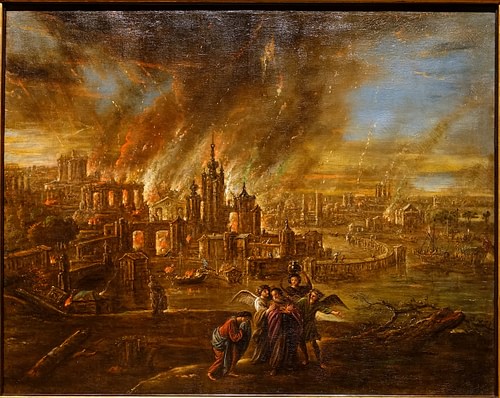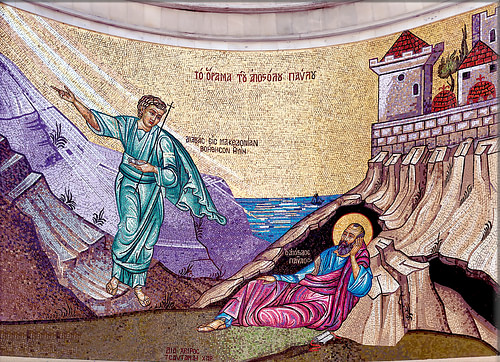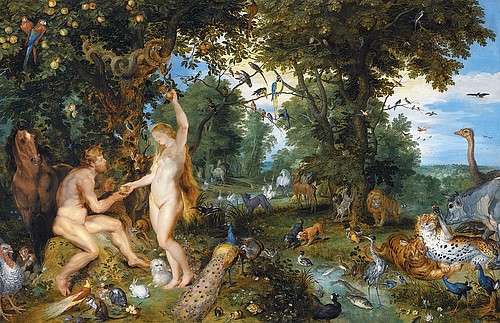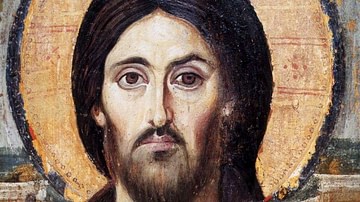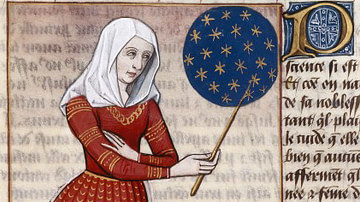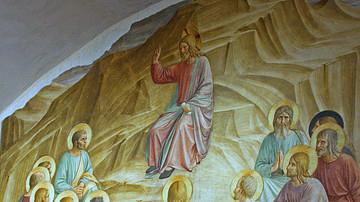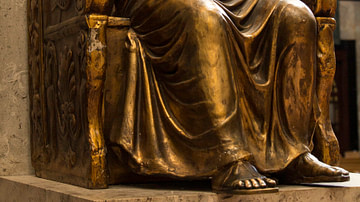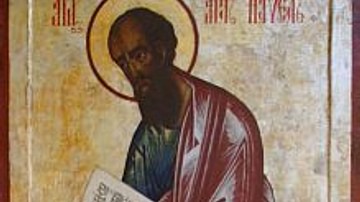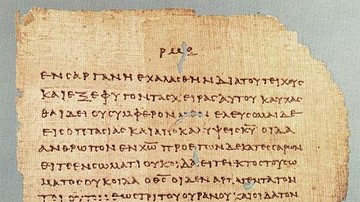In modern debates concerning homosexuality, same-sex marriages, and gender identification, it is popular to turn to the Bible for passages to validate a position. Modern culture attributes many elements in understanding homosexuality, but in the ancient world, there was no concept of what we term a gay lifestyle, nor was there any discussion of gender identification, as we understand it.
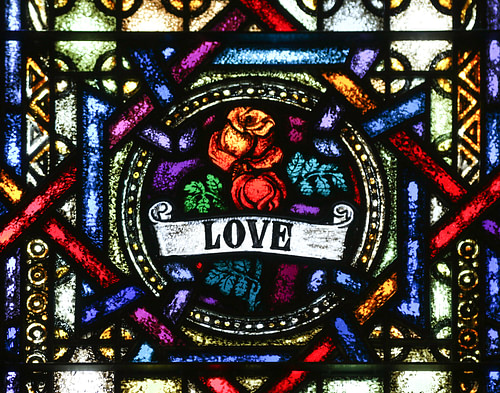
Early Christian writers were influenced by several factors when they wrote about human sexuality and behavior:
- the importance of fertility
- the traditions and dictates of Judaism
- Greco-Roman cultural and social elements
- concepts found in various schools of philosophy in relation to the body and the soul.
The evidence for Christian views and teachings on the topic are meager in the 1st century CE and in the New Testament. Most of the teaching on human sexuality arose in the 2nd century CE with the writings of the Church Fathers.
Fertility
Human sexuality was directly related to the community. In a world of harsh conditions, short life expectancy, devastating natural disasters, high infant mortality rates, and constant wars, an eons-old concept of fertility was crucially important. This included the fertility of crops, herds, and especially people. Hence the powers of nature were imagined in gendered pairs. Most gods had a female consort, or goddess, with whom they reproduced other deities. These powers received pleas for human benefits through rituals and sacrifices.
One’s sex related to the physical characteristics at birth, while one’s gender was a social construction, which organized the role and duty of each member of society. This was presented in law codes, "dictated by the gods." Society mirrored the understanding of divinities as families, so the family became the basic social structure. Men had a religious and thus civic duty to marry and produce offspring. Women were valued mainly for their role in procreation. This is the only way in which gender identification was understood. Everyone contributed to the unending struggle to convey the flow of life from generation to generation.
Influence of Judaism
Christianity began as a sect of Judaism and utilized the Jewish Scriptures as their sacred texts and source material. The importance of fertility was emphasized in the first commandment of God in Genesis (1:28): "Be fruitful and multiply." The Law of Moses dictated the rules and obligations of men and women. Women were deemed the property of men and so the violation of another man’s property, adultery, resulted in a death penalty for both. This appears harsh to modern eyes, but in a world without DNA tests, paternity had to be assured in the correct bloodline.
In modern debates on the attitudes toward same-sex relations, Christians often quote two sources from Judaism: the story of Sodom and Gomorrah in Genesis 18-19, and the legislation in the book of Leviticus 18:22.
Sodom & Gomorrah
Sodom and Gomorrah were two cities south of the Dead Sea, along a fault line of volcanic earthquakes. The larger context of the story is the narrative plot of how to get the old couple of Abraham and Sarah (who is barren) to fulfill God's promise to Abraham that he would be "the father of a great nation." The story begins with God yet again saying Sarah would get pregnant, but she laughs it off. Then three angels visit Abraham. The earliest passages of the Jewish Scriptures describe angels looking like human men. It is only later, after their exile in Babylon and then in Persia, that angels have wings (a Persian concept from Zoroastrianism).
Abraham orders Sarah to make them a meal, and two of the angels then go to investigate the hue and cry of the evil of Sodom and Gomorrah. The third angel morphs into God, and Abraham negotiates to save the cities if God could find ten good men there. The angels meet Abraham’s nephew, Lot, at the city gates of Sodom, and he welcomes them into his home. The house was surrounded by men who clamor to have Lot send out the angels, "so that we may know them," a euphemism for sexual intercourse (Genesis 19:5). Guests are inviolate in this culture, and so Lot offers his two virgin daughters. At that point, the angels tell Lot to take his household and flee the coming destruction. Another purpose of this story was to explain why the Dead Sea area is so desolate.
A common modern interpretation of this story is the equation of (the now coined term) "sodomy" with "homosexuality." Technically, sodomy means anal intercourse and can be applied to women as well. Taking this story out of its historical context and narrative function misses an important element of ancient nomadic cultures. The concept of hospitality ruled relationships, particularly in the period of the nomadic lifestyle. The harsh conditions of desert climates were offset by the idea that people helped each other when needed. Hospitality was offered, even to one’s enemy. Thus, Sarah offered a meal to the strangers, and guests being inviolate, Lot offered his daughters instead. Which was the greater "sin" of Sodom: violating the rules of hospitality, or the idea of male intercourse with other males?
Leviticus
The third book of the Jewish Scriptures, Leviticus, summarizes the legislation received on Mt. Sinai by Moses after the Hebrews escaped from Egypt. It is essentially a "priests’ manual" because it contains the (later) adaptation of Temple rules for sacrifices and ritual purification procedures. The second half of the book includes a Holiness Codes, for the way in which Jews should maintain the land as sacred. This section denounced certain behaviors as "abominations." A normal, everyday sin (a violation of one of God’s commandments) could be atoned for with a sacrifice and the passage of time. An abomination differed in the sense that there was no ritual of atonement - one stood condemned.
Leviticus 20:13 states: "If a man lies with a male as with a woman, both have committed an abomination; they shall surely be put to death; their blood is upon them."
Blood and semen were the two sources of life and thus were set aside by God as sacred. When it came to procreation, the ancients lacked our medical knowledge; they did not know that semen regenerates. With a limited supply, it was crucial that you applied your semen for the communal good, within a marriage contract, for the survival of the group. Male relationships were condemned for "wasting the seed of life." Lesbians are not mentioned in Leviticus, and there is no text addressed to the sexual behavior of women because female relationships do not involve semen. This does not prove or disprove their existence in ancient Israel.
The Books of the Prophets
When Israel suffered national disasters (the Assyrian conquest in 722 BCE; the Babylonian conquest in 587 BCE), the Prophets of Israel attempted to explain why God had permitted these enemies to conquer. God had not failed his people, but instead had used these enemies to discipline Israel for its sins. The great sin was permitting idolatry to continue in the land. The idolatry of fertility deities gave rise to the Prophetic use of metaphors of human sexuality to describe their sins. Idolatry led to sexual immorality: "But you have lived as a prostitute with many lovers . . . You have defiled the land with your prostitution and wickedness" (Jeremiah 1:1-3). The prostitution reference was the idea that Israel committed "adultery" by turning to other gods.
The term "sexual immorality" translates from the Greek, pornea, meaning "illicit sexual unions." It often referred to incest codes or the degree of kinship permitted in marriage. Many English Bibles translate the term as "fornication." In translating the Greek Scriptures into Latin, the term fornix was adopted. Fornix is a vault or arch and was the place where prostitutes performed their street occupations in Rome under the arches. It became a euphemism for prostitution, brothels, and all forms of sexual practices not condoned by a group.
Ancient Greece, Rome & Philosophy
The sources on ancient Greece and Rome are often utilized in discussions of how these cultures condoned homosexual behavior. Modern studies include homoerotic analyses of Greek mythology and the behavior of some of the Olympian gods.
In Greek culture, relationships between older men and younger adolescents were known as pederasty ("love of boys"). Older men acted as mentors to the next generation. Their tutoring included the social graces and rules of governing. Women in Ancient Greece were kept separate from men, so social bonds between males dominated in Greek society. This was particularly true when entertaining male guests for dinner. (See Plato’s Symposium for a discussion of the different ideas related to love and relationships.)
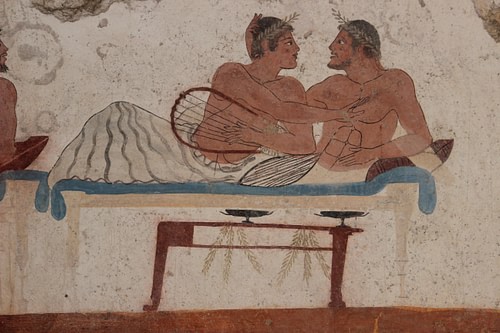
All behavior was subject to social concepts known as honor and shame, and both one's private and public persona was open to criticism. There were rules for such relationships between men. The homoerotic elements were to be done face-to-face, with the younger man serving the older. If penetration was done, it should always be performed upon the younger man. However, penetration was always criticized. Ancient medical ideas posited women as physically weaker than men which translated into social roles; men were active, women were passive. Being on the receiving end of anal intercourse placed one in the liminal area of going soft, in the passive role of a woman. These relationships were not permanent. Achieving adulthood, the younger men were expected to marry and produce children for the city-state.
Almost all our evidence for lesbian relationships in antiquity derives from references to the writings of Sappho (630-570 BCE). She was widely admired for her lyrical love poetry. Late Hellenistic tradition suggested that she ran a school for girls on the island of Lesbos, and thus the modern term. Outside of Sappho, there is sparse evidence of the behavior of female relationships of a sexual nature with other women.
Ancient Romans often derided and criticized the Greeks for their softness in these practices. That does not mean that same-sex relationships did not exist. However, much of the Roman literature is of a polemical nature, in charges against a political opponent or an unpopular Roman emperor (Tiberius, Caligula, and Nero).
Early Christianity
The gospels record no specific teachings of Jesus of Nazareth on human sexuality. The Christian tradition followed the importance of marriage and procreation of Judaism. Jesus appeared to support marriage with a reference to Genesis:
But at the beginning of creation God "made them male and female." "For this reason, a man will leave his father and mother and be united to his wife, and the two will become one flesh" . . . Therefore, what God has joined together, let no one separate (Mark 10:9).
This text is often applied by those opposing same-sex marriages. However, this passage is about Jesus’ views on divorce, which was an early debate in Christian communities.
In the middle of the 1st century CE, Paul the Apostle, a Pharisee, became a member of the new movement of Christians. A Jew of the Diaspora, Paul was educated in the Jewish Scriptures and Greco-Roman philosophy. His travels brought him into contact with contemporary lifestyles which he often criticized. Paul’s remarks on human sexuality and behavior were addressed to the way in which his communities could live proleptically, as if the kingdom of God was already here, "to live as angels" (1 Corinthians 6). In 1 Corinthians 7, Paul addressed marriage, remarriage, and divorce. He recommended that everyone "stay as they are," all social conventions would be upended in the coming kingdom.
There are only four passages in the New Testament that are relevant:
1 Corinthians 6:9-10
In a passage admonishing his community for lawsuits against each other, Paul wrote:
Or do you not know that wrongdoers will not inherit the kingdom of God? Do not be deceived: Neither the sexually immoral nor idolaters nor adulterers nor men who have sex with men nor thieves nor the greedy nor drunkards nor slanderers nor swindlers will inherit the kingdom of God.
This Jewish vice-list, as described in the literature of Hellenistic Judaism, reflected a Jewish disdain for the religious views and lifestyles of Gentiles (non-Jews). Paul reflected these attitudes and called upon Prophetic literature with their views of sexual immorality inherent in all things associated with idolatry. This passage is polemical and does not provide contemporary verification for the behavior of non-Jews.
Romans 1:26-27
Because of this (idolatry), God gave them over to shameful lusts. Even their women exchanged natural sexual relations for unnatural ones. In the same way the men also abandoned natural relations with women and were inflamed with lust for one another. Men committed shameful acts with other men and received in themselves the due penalty for their error.
This is the only place in the Bible where female sexual behavior is discussed. An early interpretation equated "unnatural ones" with unnatural sexual acts between men and women. Still others interpreted "unnatural" to refer to bestiality, although no specifics are cited. This text became utilized for the Christian ban against homosexuality for both men and women.
1 Timothy 1:9-10
1 & 2 Timothy are what scholars refer to as "deutero-Pauline" or second Paul. These are letters written in Paul’s name but by a later disciple.
We also know that the law is made not for the righteous but for lawbreakers and rebels, the ungodly and sinful, the unholy and irreligious, for those who kill their fathers or mothers, for murderers, for the sexually immoral, for those practicing homosexuality, for slave traders and liars and perjurers—and for whatever else is contrary to the sound doctrine.
Again, it includes traditional Jewish vice-lists where the polemic of the sins of the dominant culture have increased.
Hebrews 13:4
Marriage is to be held in honor among all, and the marriage bed is to be undefiled; for fornicators and adulterers God will judge.
Some modern readings of this passage claim that the term "fornicators" includes homosexuality.
Christian Adaptations to Gender Roles & Human Sexuality
In the 2nd century CE, Christian leaders no longer had ethnic ties to Judaism but retained the Jewish Scriptures for their teachings on the new movement. Known retrospectively as the Church Fathers, these men were Gentile converts who had been educated in Greco-Roman philosophy. They incorporated traditional Jewish ideas, Paul’s teaching on marriage and divorce, and philosophical concepts of asceticism.
An innovation introduced by the Church Fathers was that any form of human sexuality was now deemed a sin. In the ancient world, human intercourse was not only crucial for maintaining the survival of the group but was also understood as something pleasurable, a gift from the gods. From a philosophical point of view, human intercourse relied upon losing control of the passions. This became the sin of lust. Augustine of Hippo utilized these teachings for his doctrine of Original Sin in the Garden of Eden; lust entered the garden and was passed down to all humans at conception. Although a sin, human procreation became a concession to sin, a necessary evil because of the weakness of humans, to grow the Christian Church. Bishop Irenaeus argued that humans were made in the image of God, and their sexual lives should follow the command for procreation only (Imago Dei).
In the 2nd century CE, various groups of Christians taught different teachings of Jesus and held diverse views on human sexuality. Collectively known as Gnostics, they taught that humans contain a divine spark of God, trapped in an evil body. To stop the divine sparks from entering more bodies, Gnostic Christians were the first to practice chastity (never having sexual intercourse) and celibacy (never entering into a legal marriage contract). The Church Fathers also created the twin concepts of orthodoxy and heresy (for correct and incorrect belief) to argue against the views of Gnostic Christians. However, these men did admire both chastity and celibacy for the clergy, as ways in which to elevate the status of bishops. Renouncing all social conventions created an aura of holiness; they had sacrificed a normal life as living martyrs.
From this period on, Christian writers would promote the idea of life-long virginity as the ideal for all Christians. Young girls were handed over to the church to be taken care of and spend their lives in devotion to God, untainted by the lusts of the body. All forms of sexual intercourse and sexual relationships that did not result in procreation were condemned. Taking their views from the books of the Prophets, sexual immorality (which now meant sexual deviation) would bring on the wrath of God, just as idolatry did in the past.
Many modern Christian views on human sexuality and gender are embedded in traditions that posited Christian lifestyles in opposition to the dominant culture. This has created the image that pagans (a derogatory term coined in the 4th century CE for non-Christians) were constantly involved in sexual "orgies" (Greek for "rituals") and deviant perversions. Hollywood has fostered these ideas in their presentations of the rich and famous in ancient Rome. Versions of the Roman banquet always include orgies (and helps ratings). Most of the evidence for ancient views of the body and human sexuality derive from 1-5% of the educated elite, the upper classes. The way in which common people thought about these matters is unknown. Their prime concern was survival, and thus the traditional roles of male and female were upheld by the majority.
